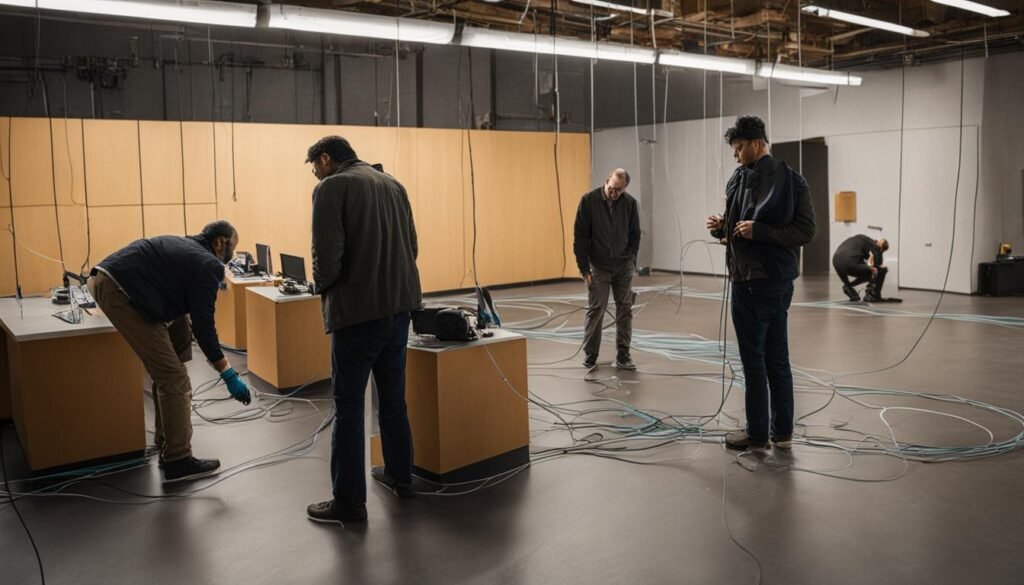Mastering How to Fix Hearing Aid Wire is crucial when encountering issues such as damaged wires or cords, which can impede the functionality of your hearing aid. Our comprehensive guide is designed to equip you with the knowledge and techniques to resolve common wire-related problems.
Whether you’re dealing with a loose connection, a broken wire, or any other wire-related issue, this guide provides detailed, easy-to-follow steps to ensure your hearing aid operates optimally. By understanding how to fix these issues, you can maintain the performance of your hearing aid, avoiding interruptions in your hearing experience. We aim to help you quickly and effectively address these challenges, ensuring your hearing aid continues functioning as intended.
Key Takeaways:
- Identify the issue with your hearing aid wire before attempting any repairs
- Seek the help of a professional audiologist for repairs beyond superficial damage
- Take precautions to avoid causing further damage when fixing your hearing aid wire
- Regular maintenance and proper storage can prevent wire damage in the future
- If in doubt, consult a professional for professional hearing aid repair
Tips for Hearing Aid Maintenance and Troubleshooting
Hearing aids require regular maintenance to ensure optimal performance. Here are some essential tips for maintaining and troubleshooting your hearing aids:
Cleaning Your Hearing Aids
Regular cleaning is crucial to remove debris and prevent moisture damage. Gently wipe your hearing aids with a soft cloth to remove any dirt or wax accumulation. Be sure to clean both the exterior and the sound outlet. Avoid using water, alcohol, or cleaning solutions, as they can damage the delicate components of your hearing aids.
Storing Your Hearing Adidas
When you’re not using your hearing aids, storing them properly is essential. Please keep them in a dry, protective case to prevent moisture damage. Avoid exposing them to extreme temperatures, such as direct sunlight or excessive heat. Additionally, remove the batteries when storing your hearing aids for an extended period.
Battery Maintenance
Regularly check the batteries of your hearing aids and replace them as needed. Low battery levels can result in reduced sound quality or unexpected power loss. It’s a good idea to keep spare batteries on hand to replace them when necessary quickly. Remember to follow the manufacturer’s instructions for battery replacement.
Troubleshooting Common Issues
If you experience any issues with your hearing aids, such as low volume or blockage, there are some troubleshooting steps you can take. Start by adjusting the volume settings on your devices. Ensure that the sound outlet is not blocked by debris or wax buildup. If the problem persists, consult the user manual or contact your hearing healthcare professional for further assistance.
Following these maintenance and troubleshooting tips, you can keep your hearing aids in excellent condition and prolong their lifespan. If you encounter any persistent issues or need professional assistance, don’t hesitate to contact your audiologist or hearing care provider.
Read Also: How to Find a Lost Hearing Aid
Understanding Hearing Loops and Their Installation
A hearing loop is a unique sound system for individuals with hearing loss. It consists of a loop amplifier, and wire looped around a room. Anyone within the circle wearing a telecoil-equipped hearing device or using a loop receiver can hear the transmitted sound.
The loop wire can be installed under the carpet, in the ceiling, or around the baseboard. It’s important to follow manufacturers’ recommendations for wire gauges and avoid running the loop wire near metal objects. This ensures optimal signal transmission and minimizes interference.

Connections to audio sources, such as TVs or telephones, can be made through a hearing loop driver. This device converts the audio input into a magnetic signal transmitted through the loop wire. The magnetic signal is then picked up by telecoil-equipped hearing devices or loop receivers, allowing individuals to hear the audio directly in their hearing aids or headphones.
Hearing Loop Installation Process:
- Identify the area where the hearing loop will be installed.
- Choose the appropriate loop wire type and gauge based on the size and layout of the room.
- Ensure the loop wire is adequately secured and concealed, following the manufacturer’s instructions.
- Connect the loop wire to the loop amplifier or driver and test the audio signal.
- Adjust the amplifier settings, such as volume and tone, to suit the needs of the hearing loop users.
- Conduct a final test to ensure the hearing loop functions properly and provides transparent sound for all users.
Installing a hearing loop in public spaces, such as theaters, churches, and conference rooms, can significantly enhance the listening experience for individuals with hearing loss. It helps eliminate background noise and reverberation, allowing for improved speech intelligibility and overall communication accessibility.
By understanding the basics of hearing loops and their installation process, individuals with hearing loss can advocate for installing these systems in public places to create a more inclusive and accessible environment for everyone.
What are the 4 types of tinnitus? Discover the intricacies of ‘what are the 4 types of tinnitus’ in our thorough exploration, categorizing and explaining the different forms of this condition.
Common Questions About Hearing Loops
When using hearing loops, many people have questions about their usage, troubleshooting, and compatibility. Understanding the answers to these common questions can help individuals with hearing loss make the most of this assistive technology. Here, we have compiled frequently asked questions to provide clarity and guidance.
Who can use a hearing loop?
Hearing loops are designed to benefit individuals with hearing loss who wear hearing aids or cochlear implants with telecoils. If your hearing device has a telecoil, you can connect to a hearing loop system and experience enhanced sound quality in looped environments.
How do I connect my devices to a hearing loop?
Connecting your devices to a hearing loop is a straightforward process. If your hearing device has a telecoil, switch it on. In looped environments, the hearing loop wire installed in the room will transmit the sound directly to your telecoil-equipped device, improving audibility and reducing background noise.
Can a hearing loop be used in different settings?
Hearing loops can be used in various settings, such as theaters, concert halls, places of worship, classrooms, and even vehicles. Hearing loop systems can be installed in large public spaces or personal environments, providing a seamless listening experience wherever they are implemented.
What should I do if I experience troubleshooting issues with a hearing loop?
If you encounter any troubleshooting issues with a hearing loop, such as interference or lack of sound, there are a few steps you can take. First, ensure your hearing device’s telecoil is activated and aligned with the hearing loop wire. If you are still experiencing difficulties, it is recommended that you consult with a professional audiologist or the venue’s hearing loop system operator for further assistance.
By understanding the usage, troubleshooting, and compatibility of hearing loop systems, individuals with hearing loss can confidently embrace this technology for improved communication and enhanced listening experiences.
Conclusion
Proper maintenance and repair of hearing aids are crucial for individuals with hearing loss. Following the steps outlined in this guide, you can ensure that your hearing aids function optimally and provide crystal-clear sound quality.
Maintaining your hearing aids is essential for their longevity and performance. Regular cleaning and storing them in a dry place when not in use can help prevent damage from debris and moisture. Replacing the batteries regularly will ensure that your hearing aids don’t unexpectedly run out of power.
If you encounter any issues with your hearing aids or hearing loops, it’s always recommended to consult with a professional audiologist. They have the expertise to handle repairs beyond superficial damage and can provide the best solutions for your needs. Remember, taking care of your hearing aids and seeking professional help when necessary will help you make the most of your hearing experience.
Frequently Asked Questions
Can I fix a damaged wire or cord on my hearing aid myself?
It is best to seek a professional audiologist’s help for any repairs beyond superficial damage. Getting your hearing aid professionally repaired is recommended to avoid causing further damage.
How do I properly maintain my hearing aids?
Regular cleaning with a soft cloth removes debris and prevents moisture damage. It would help to store your hearing aids in a dry place when not in use. It’s necessary to replace the batteries regularly to avoid unexpected power loss.
What should I do if I encounter issues with my hearing aid?
Try troubleshooting steps like adjusting the volume or cleaning the device. However, if these solutions don’t work, consulting with a professional for further assistance is best.
What is a hearing loop?
A hearing loop is a unique sound system for individuals with hearing loss. It consists of a loop amplifier, and wire looped around a room. Anyone within the circle wearing a telecoil-equipped hearing device or using a loop receiver can hear the transmitted sound.
How is a hearing loop installed?
The loop wire can be installed under the carpet, in the ceiling, or around the baseboard. It’s important to follow manufacturers’ recommendations for wire gauges and avoid running the loop wire near metal objects. Connections to audio sources, such as TVs or telephones, can be made through a hearing loop driver.
Can I use a hearing loop in different settings, such as homes or vehicles?
Yes, a hearing loop can be used in various settings, including homes and vehicles, as long as the necessary equipment is installed.
How is a hearing loop different from Bluetooth technology?
Bluetooth is a one-to-one wireless technology, while a hearing loop is one-to-many. Bluetooth connects one device directly to another, while a hearing loop transmits sound to multiple compatible devices within the circle.
What should I do if I experience interference or lack of sound through the hearing loop?
Troubleshooting steps, such as adjusting the volume, checking for obstructions, or consulting with a professional, can help address common concerns with hearing loops.
What are some common questions about hearing loops?
Some frequently asked questions include who can use a hearing loop, how to connect devices to a hearing loop, and whether a hearing loop can be used in different settings such as homes or vehicles.



